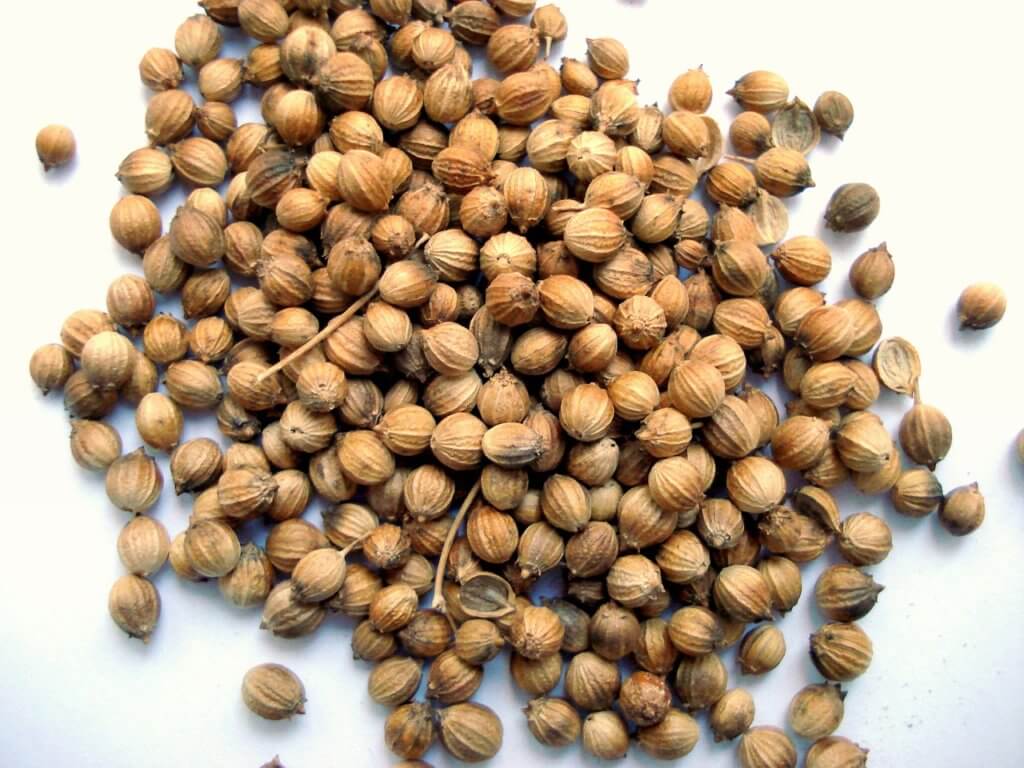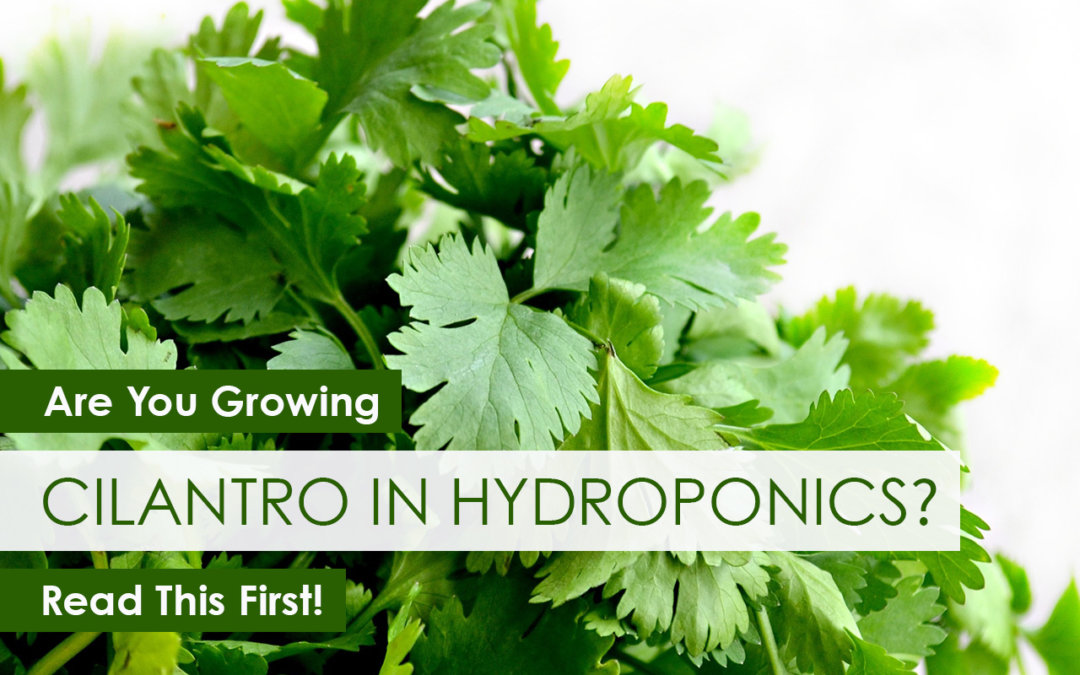Cilantro in hydroponics
Like many herbs, cilantro (Coriandrum sativum) is native to the Mediterranean area but has been spread wide across the world. Today, the herb is prominent especially in Asian and South American cooking.

The spice coriander is the seed of cilantro, although the two do not taste similar. The name “coriander” can be confusing since some people call both the green and the seed “coriander”.
Cilantro is notorious for a polarized fan/enemy base. Most people will experience either a cool, fresh taste or an unpleasant soap taste. If you’re in the first group, cilantro is a lovely addition to dishes both as a garnish and a main ingredient. If you’re looking for an experimental recipe, one of the easiest ways to try cilantro is as part of a salsa or as a topping on a curry.
Cilantro and its seed – coriander – have been used medicinally by cultures across the world for millennia.
A member of the family Apiaceae, cilantro shares traits with parsley, carrots, and dill. Like those crops, cilantro bolts a slender flower stalk with flat flowers, and self-seeds easily in horizontal growing.
While cilantro is an easy crop for soil gardeners, indoor and hydroponic growers may not get the highest space use efficiency from this crop. A longer turn and limited yield means that cilantro growers can see opportunity costs from growing something more productive. On the other hand, this herb is low-maintenance. If growers are sure that they can get good pricing (do your in-person market research!), cilantro can still be a good crop.
Since it’s small-statured, cilantro can be grown in almost any hydroponic system, so long as pH and EC ranges are appropriate.
Ideal conditions
- EC: 1.6-1.8
- pH range: 6.5-6.7
- Temperature: 40 – 75 ºF
Cilantro can be a tricky crop to grow since it bolts very easily, especially in hot conditions. This crop prefers cooler temperatures (40-75º Fahrenheit) and low salts. The preference for cool temperatures extends to germination as well; temperatures in the 60’s will result in higher germination rates than germination environments in the 70’s or 80’s.
If bolting is triggered, trim the bolts and adjust environmental conditions. Be aware that the flavor of the greens becomes more bitter and harsh once the plant has bolted. Growers can purchase slow bolting seeds to minimize the potential for crop failure.
Common pests
Two of the most common diseases of cilantro in hydroponics are bacterial leaf spot and powdery mildew. Bacterial leaf spot causes yellow spots on the leaves and is usually caused by too much moisture around the leaves or high humidity in the growing environment.
Powdery mildew is a common indoor pest that affects a wide range of greens and herbs and is symptomized by a powdery white film on vegetation. If you struggle with powdery mildew, be sure to keep the environment in the proper temperature range. As soon as you notice a powdery mildew outbreak, remove the affected vegetation. Some sprays can help as well; see this article for more information on controlling powdery mildew.
Like most crops, cilantro is vulnerable to Pythium. Pythium can become problematic in systems with inadequate aeration around the roots.
Timeline & harvesting
Cilantro seeds germinate in 7-10 days, with leaves ready to harvest 40-48 days (5 ½ – 7 weeks) later. From seed to harvest, cilantro takes 50-55 days.
Cilantro can be harvested fully or partially, requiring very little maintenance like trimming. If using a partial harvest, the first harvest will take place at about 5 weeks after transplant and the second at about 8 weeks after transplant. The second harvest will be lower than the first. (Our trials yielded 3-4 and 2-3 lbs respectively.)
 Cilantro may be packaged various ways depending on the farmer and (even more importantly) market preference. Common packaging options are 0.75-1.0 oz clamshells or 1-2 oz. bunches.
Cilantro may be packaged various ways depending on the farmer and (even more importantly) market preference. Common packaging options are 0.75-1.0 oz clamshells or 1-2 oz. bunches.
After purchase, consumers are advised to store their cilantro in the fridge. Keeping the cilantro in a glass of water like flowers can help extend shelf life.
Retail pricing for cilantro in grocery stores typically ranges from .33-.99/bunch. Given that your cilantro is likely locally grown and marketed and assuming that one bunch is 0.75-1.0 oz., local cilantro pricing could range from $0.5 – $2.0/oz.
Choose your crops!
To choose a crop set, you need several crops with overlapping pH, EC, and temperature preferences. You can get all of this information in the Recommended Crop List, a list of crops that excel in ZipGrow Towers.




this stuff drinks way too much water
I’m growing cilantro, and in the past I can smell it as it’s growing and it’s wonderful. This round though, there’s no noticeable scent, and the taste it seriously lacking. So much so I was worried I has somehow ended up with parsley seeds lol. I’m not sure what has changed as my set up is the same. Do you have any tips?
Hi CC,
Check your production temperatures as that can influence volatile oil production (scent). It could also be that you need to alter your irrigation routine.
I am growing mine in an aquaponics system, temp 26C, pH 7. Just tasted a leaf and its super yummy and floral. I have no idea of the EC, I just use aquarium test kits. I have been struggling with maintaining a high carbonate hardness, the water is soft here in Vancouver canada.
Hello—
If pH is staying consistently near 7, I wouldn’t mess with it. If it is regularly dropping below 6.8, potassium carbonate and calcium carbonate can be added to increase hardness and pH buffering capacity.
Hi, should I add calcium nitrate and magnesium sulfate?
Of course.
How to make hydroponic solution for calintro at home ?
By mass (or weight):
1 unit npk (miracle gro)
1 unit calcium nitrate
1/2 unit epsom salt
.65 unit triple Super phosphate
1.16 unit kcl (muriate of potash)
Triple Super phosphate is a fertilizer & a buffer & a ph down. Don’t skip it.
Mix them separately in water. Add them in order once per day until ppm (ec) is reached.
If possible, use rainwater.
I use Astro garden for my seeds is that ok to use
How to make hydroponic solution for calintro at home ?
Is coriander can be grown in larger areas through hydrophonic techniques.
I use a floating raft.
UNANSWERED SOAPY CILATRO TASTE QUESTION!!!
i have a question that i have spent many hours trying to research, many others have asked the same question on countless forums and not one time have i found the right answer for me. the question is why does my hydroponic cilantro taste like soap???
Before you answer the same as what everyone else answers which is “Genes” or some people have something in their body’s that make cilantro taste like soap etc… that is probably right but not with me because we ( my wife and family) have been eating cilantro all our lives and i know how it should taste, i buy it on a weekly basis for the past 20 years so it’s not Genes at all. plus i bought many times ( even today) and compared it to what i am growing and it is completely different than what i grow.
anyway nobody including myself could eat it, its awful, the first time i ruined a whole pot of soup. i have tried many different seeds, and been trying to grow it for about a year now and it all tastes the same, BAD and Like SOAP. i have even tried removing the roots and soaking for days in just water to try to take the taste away and nothing works.
my ph is always within range, i am using a NFT hydroponics system and i use the 3 part general hydroponics nutrients mix. roots are nice and it grows looking big and healthy looking. I’m using LED lights ( Spyder) i have tried all levels of TDS ranges from 700, 900,1200,1400 and 1500 and it all does the same. i also tried many batches with and whiteout the use of pesticides. i have thrown out many pounds of cilantro and never been able to eat it at any stage in its growth.
if you can answer this question you will be the first on the entire internet!!! i have tried as mentioned for months and spent hours reading and nobody answers this common question other then it certain peoples genes. i hope you can help!!
In a school-based hydroponic operation with restaurant and commercial salsa company clients, I’m struggling with germination of Cilantro. I’m using plugs by International Hort Supplies, a coco coir type, and am placing 4-5 seeds into each, and germination is sporadic. Any suggestions? I can try Rockwool, but don’t like it due to fact that they don’t sit on bottom of NFT channels, and tend to dry off and flake, plugging the system. Any suggestions welcome.
I place my seeds between damp paper towels then put into a sealed plastic bag. It takes about a week or longer to germinate but eventually all the seeds come through. As they sprout, I place them carefully into rockwool and hydroponic system. Using this method, I no longer have problems with germination.
When germinating the seeds try splitting the seed pods in half. It’ll make it easier for the plant to start growing.